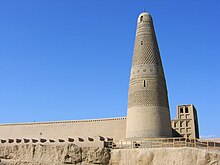Emin Minaret
| Emin Minaret | |||||||||

Emin Minaret and Mosque
|
|||||||||
| Chinese name | |||||||||
|---|---|---|---|---|---|---|---|---|---|
| Traditional Chinese | 蘇公塔 | ||||||||
| Simplified Chinese | 苏公塔 | ||||||||
|
|||||||||
| Alternative Chinese name | |||||||||
| Chinese | 额敏塔 | ||||||||
| Literal meaning | Emin Minaret | ||||||||
|
|||||||||
| Persian name | |||||||||
| Persian | مناره امین | ||||||||
| Transcriptions | |
|---|---|
| Standard Mandarin | |
| Hanyu Pinyin | Sūgōng Tǎ |
| Wade–Giles | Su1-kung1 T'a3 |
| Transcriptions | |
|---|---|
| Standard Mandarin | |
| Hanyu Pinyin | É'mǐn Tǎ |
| Wade–Giles | E2'-min3 T'a3 |
The Emin Minaret or Emin Tower stands by the Uyghur mosque located in Turfan, Xinjiang, China. At 44 meters (144 ft) it is the tallest minaret in China. The Qing Empire conquered this largely Muslim region in the 1750s by defeating the Dzungar Mongols with their superior weaponry in a series of battles. The Uyghurs under Emin Khoja joined the Qing Empire for protection against the Dzungars and the Emin minaret was named after Emin Khoja.
The minaret was started in 1777 during the reign of the Qianlong Emperor (r. 1735–1796) and was completed only one year later. It was financed by local leaders and built to honor the exploits of a local Turpan general, Emin Khoja, hence the name "Emin". The Emin Minaret is located along the ancient Silk Route (near the ancient Uyghur capital of Gaochang). Nearby is the site of the Bezeklik Thousand Buddha Caves.
The arid landscape of southern Xinjiang has long been connected to both East Asia and West Asia by historical trade routes such as the Silk Road and the land around these crossroads became the location for most of the Uyghur Islamic structures in Xinjiang. The area has long served as a conduit for cultural exchange between different ethnic and religious groups. The Emin Minaret, like other Uyghur mosques and minarets, reflects this in its combination of traditional Islamic features and local Uyghur building traditions.
The Emin Minaret was constructed by local craftsmen using local materials. The structure itself is made of wood and brick. It is an elegant, circular, tapered Islamic dome, with a diameter over 14 meters (46 feet) at its base and tapering to 2.8 meters at the top. The exterior is of sun-dried yellow bricks that narrow in shape as the tower rises. The richly textured bricks are carved into intricate, repetitive, geometric and floral mosaic patterns, such as stylized flowers and rhombuses. This mixture of Chinese and Islamic features is seen only in minarets in China. The unique geometric patterns are characteristic of Islamic architecture and have no counterparts in the architecture of China other than in Muslim structures. Positioned in the tower are several long, narrow windows at different heights and facing different directions that provide light and ventilation. The minaret has no stories. Inside, the spiraling internal support serves as a winding 72-step staircase to the top.
...
Wikipedia
